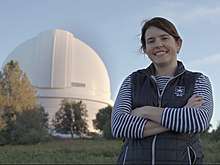Jessie Christiansen
Jessie Christiansen is an Australian astrophysicist working at the NASA Exoplanet Science Institute at Caltech. She won the 2018 NASA Exceptional Engineering Achievement Medal for her work on the Kepler planet sample.
Jessie Christiansen | |
|---|---|
 Christiansen at Palomar Observatory in 2018 | |
| Alma mater | University of New South Wales
Australian National University Griffith University |
| Employer | NASA Exoplanet Science Institute Caltech |
| Known for | Exoplanets, Citizen Science |
Education
In 2002 Jessie Christiansen completed a Bachelor of Science (Advanced Studies) in physics and mathematics at Griffith University, Brisbane. She then continued her studies to receive a BSc first class honours in Astronomy at the Australian National University, Canberra.[1] She completed a PhD at the University of New South Wales in 2007, under the supervision of Michael Ashely.[2] Her PhD required observations at the Automated Patrol Telescope at Siding Spring Observatory.[3]
Research
After Christiansen's PhD, she worked as Postdoctoral Research Fellow at the Harvard-Smithsonian Centre for Astrophysics.[4] Christiansen works on the NASA Kepler mission, cataloguing the exoplanets within the Kepler field.[5] As a member of the Kepler Science Team, she won the NASA Group Achievement Award in 2010. She is involved in the planning for the upcoming NASA TESS mission, which will search the whole sky for the nearest planets to Earth.[4]
Christiansen uses Citizen Science and the Zooniverse to help in her quest for exoplanets using the Kepler Space Telescope K2 dataset.[6][7] She worked with Professor Ian Crossfield at MIT to ensure the K2 data was made public, and in January 2018 announced the discovery of 5 massive exoplanets orbiting the sun-like star K2-138.[8][9][10][11][12] The exoplanets make up the longest chain of synchronised exoplanets ever discovered, orbiting in near-perfect resonance to their star.[13][14] In an interview with the BBC, Christiansen spoke about the importance of crowdsourcing research projects "people anywhere can log on and learn what real signals from exoplanets look like, and then look through actual data collected from the Kepler telescope to vote on whether or not to classify a given signal as a transit, or just noise,".[15]
Alongside being the plenary speaker at academic conferences, Christiansen gives public talks about her research.[16][17] She has returned to her alma mater, ANU, to discuss her research "Characterising the Kepler Survey Completeness".[18] In July 2018 Christiansen won the NASA Exceptional Engineering Achievement Medal for her work on the Kepler planet sample.[19]
Public engagement
Christiansen appeared on the Discovery Science program NASA's Unexplained Files.[20] She recorded a panel discussion at Caltech, talking about the science behind Syfy's The Expanse.[21] In 2018 she will appear in Ali Alvarez's documentary Under The Same Stars, about American women astrophysicists. She also discusses exoplanets and the Kepler mission on popular science podcasts.[22][23]
Her writing has appeared on popular science websites, including the New Scientist,[24] Smithsonian Magazine,[25] and BBC News.[26] In 2015 Christiansen joined 278 other scientists in a letter to the New York Times to object to their article that mimized the trauma of people who accused Professor Geoff Marcy of sexual advances.[27][28]
References
- "Introducing Jessie Christiansen". astrotweeps. 2016-04-04. Retrieved 2018-01-16.
- "Michael Ashley". newt.phys.unsw.edu.au. Retrieved 2018-01-16.
- Hidas, Marton; Webb, John; Ashley, Michael; Phillips, Andre; Christiansen, Jesse; Hamacher, Duane Willis; Curran, Stephen; Irwin, M.; Agrain, S. (2007). "The University of New South Wales Extrasolar Planet Search". Transiting Extrapolar Planets Workshop: 45–50.
- "Our Home, the Milky Way Galaxy". Universe of Learning. Retrieved 2018-01-16.
- "SEMINAR: Jessie Christiansen [IPAC Caltech]". www.cpp.edu. Retrieved 2018-01-16.
- "Zooniverse". www.zooniverse.org. Retrieved 2018-01-16.
- "New Features | Zooniverse". blog.zooniverse.org. Retrieved 2018-01-16.
- "Five-Planet System Found: K2-138 | Astronomy | Sci-News.com". Breaking Science News | Sci-News.com. Retrieved 2018-01-16.
- Greicius, Tony (2018-01-11). "Multi-planet System Found Through Crowdsourcing". NASA. Retrieved 2018-01-16.
- "Multi-planet System Found Through Crowdsourcing". NASA/JPL. Retrieved 2018-01-16.
- Dvorsky, George. "Star System With Five Rocky Planets Discovered by Amateur Astronomers". Gizmodo. Retrieved 2018-01-16.
- "Citizen Scientists Discover Five-Planet System | Caltech". The California Institute of Technology. Retrieved 2018-01-16.
- "Music of the spheres: chain of planets rotates at "perfect | Cosmos". cosmosmagazine.com. Retrieved 2018-01-16.
- Christiansen, Jessie L.; Crossfield, Ian J. M.; Barentsen, Geert; Lintott, Chris J.; Barclay, Thomas; Simmons, Brooke D.; Petigura, Erik; Schlieder, Joshua E.; Dressing, Courtney D. (2018-01-11). "The K2-138 System: A Near-Resonant Chain of Five Sub-Neptune Planets Discovered by Citizen Scientists". The Astronomical Journal. 155 (2): 57. arXiv:1801.03874. Bibcode:2018AJ....155...57C. doi:10.3847/1538-3881/aa9be0.
- Rincon, Paul (2018). "Citizen science bags five-planet haul". BBC News. Retrieved 2018-01-16.
- "Exoplanets I Pre-registered Participants | Exoplanets I Conference". www.exoplanetscience.org. Retrieved 2018-01-16.
- "Jessie Christiansen". web.ipac.caltech.edu. Retrieved 2018-01-16.
- Director, RSAA; webmaster@mso.anu.edu.au (2013-08-13). "Colloquia Recordings". Research School of Astronomy & Astrophysics. Retrieved 2018-01-16.
- Mohon, Lee (2017-07-05). "2017 Agency Honor Awards". NASA. Retrieved 2018-07-28.
- "Is There Life On Kepler-186f? - NASA's Unexplained Files | Science". www.sciencechannel.com. Retrieved 2018-01-16.
- caltech (2017-02-03), The Science Behind "The Expanse" - 1/25/17, retrieved 2018-01-16
- Jessie Christiansen and the hedonic treadmill of planets., retrieved 2018-01-16
- "Episode 42: Finding exoplanets with Dr. Christiansen". Spacepod. Retrieved 2018-01-16.
- "Superfast spinning stars cause strangest weather in the universe". New Scientist. Retrieved 2018-01-16.
- Redd, Nola Taylor. "How a Young Jupiter Acted as Both Protector and Destroyer". Smithsonian. Retrieved 2018-01-16.
- Webb, Jonathan (2016). "Star clumps 'good bet for alien life'". BBC News. Retrieved 2018-01-16.
- Overbye, Dennis (2015-10-10). "Geoffrey Marcy, Astronomer at Berkeley, Apologizes for Behavior". The New York Times. ISSN 0362-4331. Retrieved 2018-01-16.
- "Letter to NY Times". www.astronomy.ohio-state.edu. Retrieved 2018-01-16.
External links
- Homepage Jessie Christiansen at NASA Exoplanet Science Institute